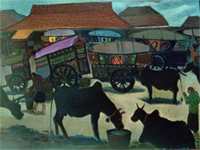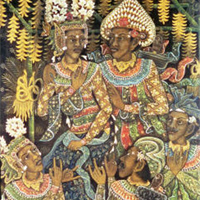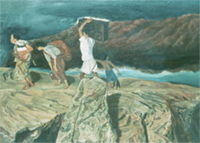Overview
The Claire Holt Papers, #14-27-2648 (see archival guide), comprise approximately 1,780 slides of Indonesia, which were created for the Cornell Indonesian Arts Project. Subjects include art, architecture, ceremonies, landscapes, painting, people, sculpture, textiles, and theater. The manuscript collection also contains typescript notes about a trip to Indonesia in 1955-1956.
The digital image collection is currently available to CORNELL USERS ONLY:
Search/browse the digital collection
Claire Holt Biography
Claire Holt was born in Riga, Latvia in 1901. She served as a reporter for the The New York World, publishing dance reviews. She traveled to Indonesia in 1930 where she studied dance, working with the anthropologist Willem Stutterheim, and then assisting the Swedish dance archivist and patron Rolf de Mare with his photo and film documentation of Indonesian dance. She returned to the U.S. and served as a research assistant to Margaret Mead, as a research analyst for the Office of Strategic Services, and as a foreign affairs specialist for the State Department. She came to Cornell University, where in 1962, she helped found the Modern Indonesia Project.
Featured Artists

“Jogja Oxcarts” by Batara Lubis. Oil, 1956.
Batara Lubis
Lubis, an accomplished drummer as well as a painter, used the many locations in which he lived as inspirations for his artwork. His style ranges from winding, ornate designs to simple shapes and brash colors, depending upon his current surroundings. Because of the different roles he played in each location (head of his clan, son of the chief, or artist), he focused on using colors rather than struggling to portray societal realities like many of his contemporaries.

“Ardja” by Ida Bagus Madé Nadera. Tempera on cloth, 1956.
Ida Bagus Madé Nadera
Raised in the village of Tegallingga, Nadera stands out among other Balinese painters beause of his tendency to make the human faces in his works, both male and female, resemble his own face. As Balinese art is usually devoid of self-portaiture, Nadera's creations are quite exceptional.

“Pengungsi” by Sudjojono. Oil, 1950.
S. Sudjojono
Sudjojono is widely regarded as one of the forefathers of modern Indonesian painting. Adopted by an impressed art teacher when his family moved to another village, Sudjojono's style gradually shifted from sketching soldiers to an expressionism inspired by Van Gogh. By 1937, he had formed Persagi, a group of artists dedicatd to revitalizing Indonesian art. He was also a prominent political figure during Japanse occupation.